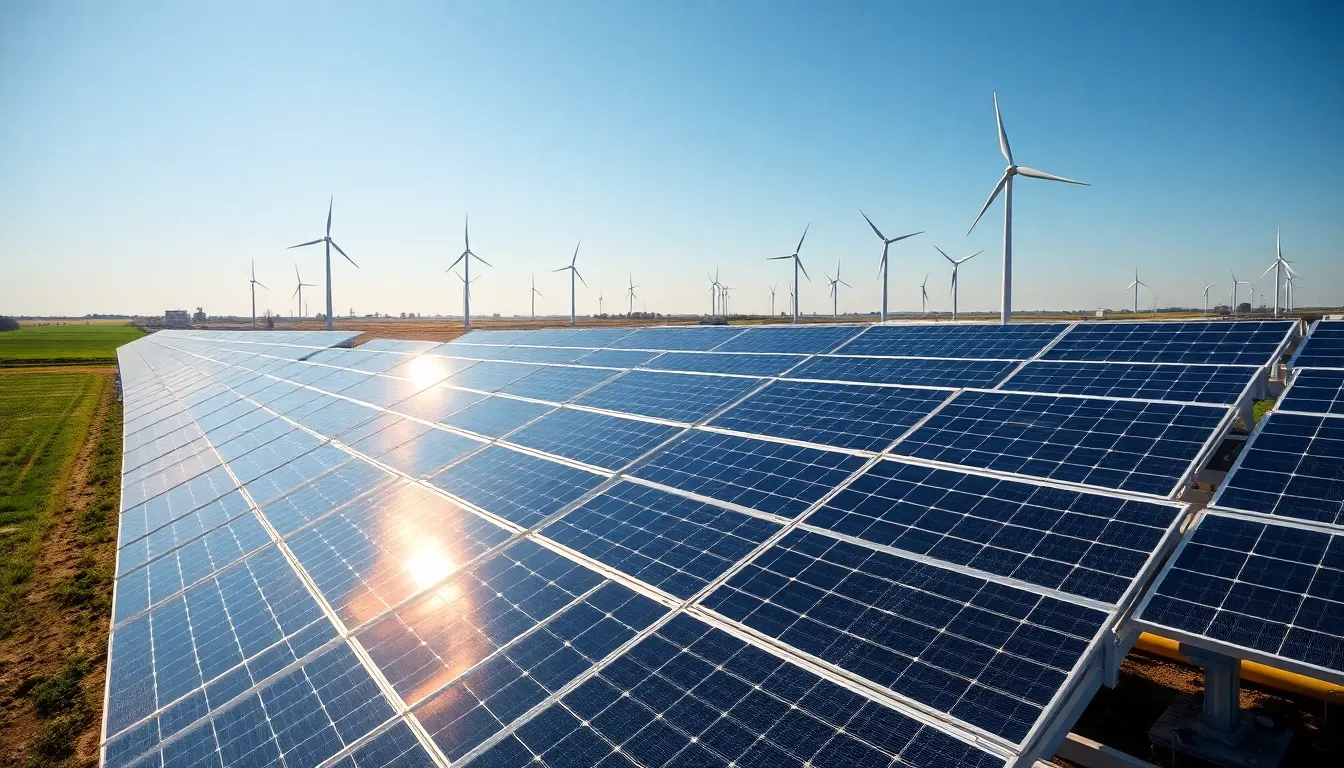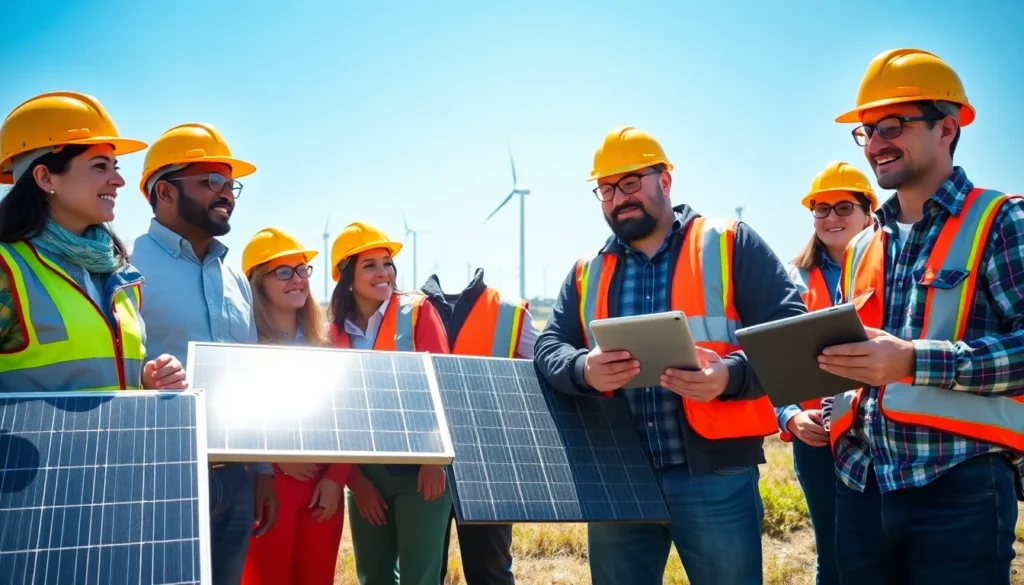Table of Contents
ToggleAs the world grapples with climate change and dwindling fossil fuel reserves, renewable energy innovations are stepping into the spotlight. These groundbreaking advancements not only promise a cleaner planet but also offer sustainable solutions for energy needs. From solar panels that capture sunlight more efficiently to wind turbines that harness the power of the breeze, the landscape of energy production is rapidly evolving.
Innovations in renewable energy are reshaping industries and redefining how communities approach sustainability. They’re not just about technology; they represent a shift in mindset towards a greener future. By exploring these exciting developments, we can better understand how they contribute to a more sustainable and resilient world.
Overview of Renewable Energy Innovations
Renewable energy innovations focus on sustainable solutions in the wake of climate change and fossil fuel depletion. Technologies like solar panels and wind turbines undergo rapid improvements, increasing efficiency and decreasing costs.
Key Innovations
- Solar Panel Efficiency: Recent advancements in solar technology, including bifacial panels, enhance energy capture. These panels can generate electricity from both sides, improving overall efficiency by up to 30%.
- Wind Turbine Design: The latest wind turbines feature larger blades and advanced materials, allowing them to harness more wind energy. New designs can increase energy output by 20% compared to previous models.
- Energy Storage Systems: Innovations in battery technology, especially lithium-ion and flow batteries, offer improved storage capabilities. These systems enable better management of energy supply and demand, facilitating a more reliable renewable energy grid.
- Hydrogen Production: Green hydrogen, produced using renewable energy for electrolysis, represents a breakthrough. It serves as a clean fuel option, particularly for industries and transportation, with no carbon emissions during combustion.
- Geothermal Energy Advances: Enhanced geothermal systems (EGS) expand geothermal energy’s potential. By accessing hot rock resources at greater depths, EGS can significantly increase geothermal energy production.
- Bioenergy Developments: Innovations in biomass conversion technology enable efficient energy extraction from organic materials. New methods, such as anaerobic digestion, produce biogas, reducing waste and providing renewable energy simultaneously.
Collectively, these innovations play a crucial role in shifting the global energy paradigm towards sustainability. Continued investment and research into these technologies drive the transition to a low-carbon energy future.
Key Technologies in Renewable Energy

Renewable energy innovations play a crucial role in advancing sustainable energy solutions. Key technologies within solar, wind, and bioenergy sectors are transforming the energy landscape.
Solar Energy Innovations
Solar energy technologies have significantly evolved. Bifacial solar panels capture sunlight from both sides, improving energy generation by up to 30%. Concentrated solar power (CSP) systems generate electricity by utilizing mirrors or lenses to focus sunlight onto a small area, enhancing efficiency. Thin-film solar cells offer lightweight, flexible options, lowering installation costs. Moreover, advancements in solar tracking systems optimize panel positioning relative to the sun, increasing energy output by approximately 25%.
Wind Energy Innovations
Wind energy technologies continue to advance rapidly. Larger wind turbine designs have increased energy output by 20%, maximizing efficiency and reducing costs. Floating wind farms expand operational areas, enabling installation in deeper waters. Innovations in turbine materials, such as carbon fiber blades, enhance durability while reducing weight. Additionally, predictive maintenance technologies utilize AI to foresee mechanical issues, improving reliability and operational uptime.
Bioenergy Innovations
Bioenergy technologies leverage organic materials for energy production. Anaerobic digestion converts organic waste into biogas, providing a renewable energy source while reducing landfill use. Advanced biofuels, produced from non-food biomass, lower greenhouse gas emissions compared to conventional fossil fuels. Innovations in pyrolysis enable the conversion of biomass into bio-oil, a versatile renewable energy source. Furthermore, carbon capture technologies integrated into bioenergy systems enhance sustainability by reducing emissions associated with biomass combustion.
Benefits of Renewable Energy Innovations
Renewable energy innovations provide significant advantages across various dimensions, shaping a more sustainable future. Advantages include positive environmental impacts and economic benefits that drive transition efforts.
Environmental Impact
Renewable energy innovations substantially lower greenhouse gas emissions, reducing the carbon footprint associated with energy production. Technologies such as solar panels and wind turbines produce energy without depleting natural resources or generating harmful pollutants. Additionally, innovations in energy storage, like advanced lithium-ion and flow batteries, enhance grid reliability and minimize waste, leading to fewer disruptions. These changes contribute to healthier ecosystems and biodiversity preservation, ensuring that natural habitats remain intact.
Economic Advantages
Renewable energy innovations lead to reduced energy costs over time. Solar and wind energy generation costs have dropped by over 80% in the past decade, making them competitive with traditional fossil fuels. Jobs in the renewable sector are also increasing, with the International Renewable Energy Agency (IRENA) reporting over 11 million jobs globally in 2018, projected to rise significantly as the sector continues to expand. Moreover, investments in renewable energy drive local economies and foster energy independence, reducing reliance on imported fuels. These factors combine to enhance long-term economic stability and create a sustainable energy landscape.
Challenges Facing Renewable Energy Innovations
Renewable energy innovations face various challenges that hinder their widespread adoption and efficacy. Key barriers include technological hurdles and policy and regulatory issues that need addressing for successful implementation.
Technological Hurdles
Technological challenges impede the progress of renewable energy innovations. High costs of advanced materials and manufacturing processes limit scalability. Efficiency and reliability of renewable technologies remain areas for improvement. For example, solar panels and wind turbines often experience performance variances based on weather conditions, impacting overall energy outputs. Energy storage technologies, although advancing rapidly, still struggle with high costs and limited capacity. Longer lifespans and increased efficiency in batteries are crucial for integrating renewable sources into the energy grid. Additionally, infrastructure and grid connectivity must evolve to accommodate distributed energy generation effectively.
Policy and Regulatory Issues
Policy and regulatory challenges also pose significant obstacles for renewable energy innovations. Inconsistent policies and lack of long-term commitment from governments create uncertainty for investors and developers. Regulatory frameworks often lag behind technological advancements, leading to administrative bottlenecks that hinder project development. Incentives like tax credits or grants can drive renewable energy investment; however, fluctuations in political priorities can impact their availability. Furthermore, international trade policies can affect access to crucial technologies and materials, complicating global supply chains. Comprehensive and stable policies that support renewable energy integration into existing energy markets are essential for fostering innovation and ensuring sustainable growth.
Future Trends in Renewable Energy Innovations
Advancements in renewable energy continue to reshape the global energy landscape. Emphasis on integrating artificial intelligence (AI) into energy management systems enhances grid efficiency and optimizes energy distribution. AI algorithms predict energy demand patterns, allowing for more responsive and adaptable grid operations.
Improvements in solar technology focus on multi-junction solar cells. These cells capture a broader spectrum of sunlight, boosting conversion efficiencies beyond 40%. The development of perovskite solar cells also shows promise, aiming for lower production costs with significant efficiency gains.
Growth in offshore wind energy technologies prioritizes floating wind turbines. These designs can harness stronger and more consistent wind resources found in deeper waters, increasing installation feasibility and energy yield. In addition, enhanced turbine materials improve resilience against harsh marine environments, extending the lifespan of offshore wind farms.
Innovations in energy storage systems lead to the exploration of solid-state batteries. These batteries offer higher energy densities and increased safety compared to traditional lithium-ion batteries. Alternative storage solutions like pumped hydro storage and compressed air energy storage gain traction, providing large-scale energy balancing capabilities.
The bioenergy sector embraces next-generation biogas production methods. Technologies such as microalgae cultivation and waste-to-energy anaerobic digestion enhance efficiency, offering high yields of renewable energy from organic waste materials. Advancements in carbon capture and utilization (CCU) technologies further promote the conversion of emissions into usable energy products.
Green hydrogen production sees significant advancements through electrolysis technologies. Developments in renewable-powered electrolyzers improve efficiency, making hydrogen a viable option for energy storage and transportation fuel. Additionally, strategies for using hydrogen in industrial applications target carbon emissions reduction.
Collaboration between private sectors and governments accelerates research and development efforts. Increased funding for renewable innovations fosters competitive advancements, contributing to a sustainable energy future. Efforts to standardize technologies across regions support scalability and globalization of renewable energy solutions.
Overall, these trends underscore the ongoing global commitment to enhancing renewable energy frameworks, addressing both environmental challenges and energy demands.
The landscape of renewable energy is rapidly evolving thanks to innovative technologies that promise a sustainable future. Breakthroughs in solar, wind, and bioenergy not only enhance efficiency but also significantly reduce environmental impact. As advancements continue to emerge, they pave the way for a cleaner energy matrix that supports economic growth and job creation.
Despite existing challenges, the commitment to overcoming these barriers is evident. Collaboration among stakeholders will be crucial in driving the necessary changes in policy and infrastructure. Embracing these innovations will not only address immediate energy needs but also ensure a resilient and sustainable world for generations to come.





